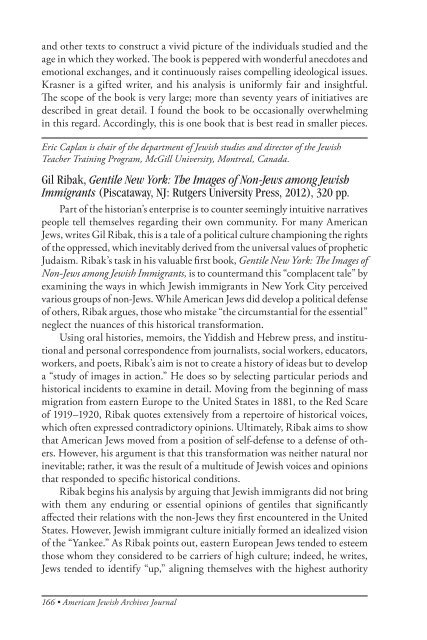American Jewish Archives Journal, Volume 64, Numbers 1 & 2
American Jewish Archives Journal, Volume 64, Numbers 1 & 2
American Jewish Archives Journal, Volume 64, Numbers 1 & 2
You also want an ePaper? Increase the reach of your titles
YUMPU automatically turns print PDFs into web optimized ePapers that Google loves.
and other texts to construct a vivid picture of the individuals studied and the<br />
age in which they worked. The book is peppered with wonderful anecdotes and<br />
emotional exchanges, and it continuously raises compelling ideological issues.<br />
Krasner is a gifted writer, and his analysis is uniformly fair and insightful.<br />
The scope of the book is very large; more than seventy years of initiatives are<br />
described in great detail. I found the book to be occasionally overwhelming<br />
in this regard. Accordingly, this is one book that is best read in smaller pieces.<br />
Eric Caplan is chair of the department of <strong>Jewish</strong> studies and director of the <strong>Jewish</strong><br />
Teacher Training Program, McGill University, Montreal, Canada.<br />
Gil Ribak, Gentile New York: The Images of Non-Jews among <strong>Jewish</strong><br />
Immigrants (Piscataway, NJ: Rutgers University Press, 2012), 320 pp.<br />
Part of the historian’s enterprise is to counter seemingly intuitive narratives<br />
people tell themselves regarding their own community. For many <strong>American</strong><br />
Jews, writes Gil Ribak, this is a tale of a political culture championing the rights<br />
of the oppressed, which inevitably derived from the universal values of prophetic<br />
Judaism. Ribak’s task in his valuable first book, Gentile New York: The Images of<br />
Non-Jews among <strong>Jewish</strong> Immigrants, is to countermand this “complacent tale” by<br />
examining the ways in which <strong>Jewish</strong> immigrants in New York City perceived<br />
various groups of non-Jews. While <strong>American</strong> Jews did develop a political defense<br />
of others, Ribak argues, those who mistake “the circumstantial for the essential”<br />
neglect the nuances of this historical transformation.<br />
Using oral histories, memoirs, the Yiddish and Hebrew press, and institutional<br />
and personal correspondence from journalists, social workers, educators,<br />
workers, and poets, Ribak’s aim is not to create a history of ideas but to develop<br />
a “study of images in action.” He does so by selecting particular periods and<br />
historical incidents to examine in detail. Moving from the beginning of mass<br />
migration from eastern Europe to the United States in 1881, to the Red Scare<br />
of 1919–1920, Ribak quotes extensively from a repertoire of historical voices,<br />
which often expressed contradictory opinions. Ultimately, Ribak aims to show<br />
that <strong>American</strong> Jews moved from a position of self-defense to a defense of others.<br />
However, his argument is that this transformation was neither natural nor<br />
inevitable; rather, it was the result of a multitude of <strong>Jewish</strong> voices and opinions<br />
that responded to specific historical conditions.<br />
Ribak begins his analysis by arguing that <strong>Jewish</strong> immigrants did not bring<br />
with them any enduring or essential opinions of gentiles that significantly<br />
affected their relations with the non-Jews they first encountered in the United<br />
States. However, <strong>Jewish</strong> immigrant culture initially formed an idealized vision<br />
of the “Yankee.” As Ribak points out, eastern European Jews tended to esteem<br />
those whom they considered to be carriers of high culture; indeed, he writes,<br />
Jews tended to identify “up,” aligning themselves with the highest authority<br />
166 • <strong>American</strong> <strong>Jewish</strong> <strong>Archives</strong> <strong>Journal</strong>
















